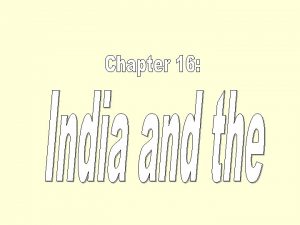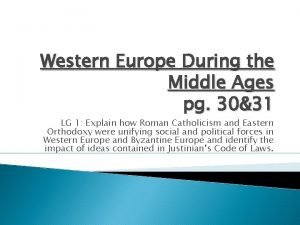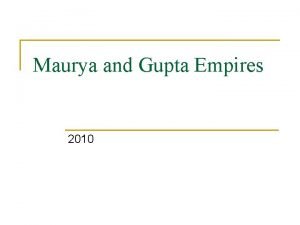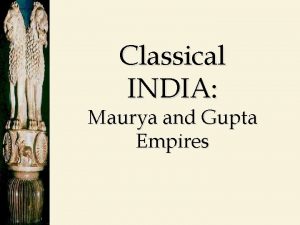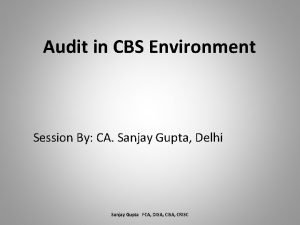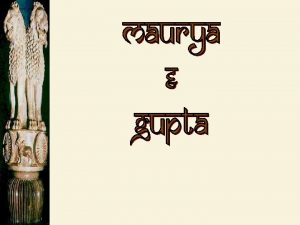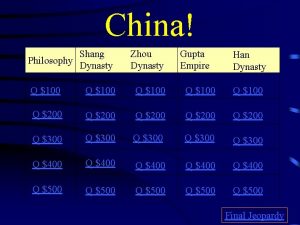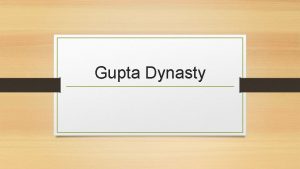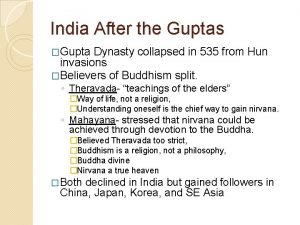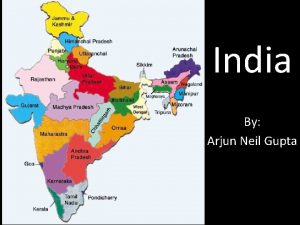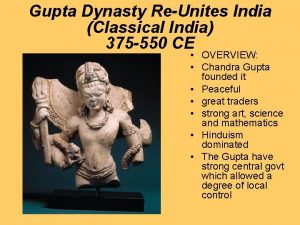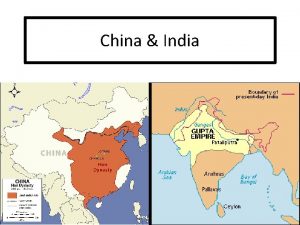India India after the fall of the Gupta



















- Slides: 19

India

India after the fall of the Gupta dynasty � 451 CE the White Huns from Central Asia invaded and disrupted administration �Mid 6 th century Gupta Empire collapsed �From the end of the Gupta until the 16 th century, when the Turkish Mughals extended their empire, India was politically divided

The quest for centralized power �Northern India � Turbulent and chaotic �Southern India

Islamic introduced to Northern India � The Sind were conquered by Arab Muslims and passed to Abbasids � Muslim merchants formed small communities in all major cities of coastal India � Turkish migrants and Islam: Turks convert to Islam in tenth century � Some moved to Afghanistan and established an Islamic state � Mahmud of Ghazni, Turk leader in Afghanistan, made expeditions to northern India � The sultanate of Delhi (1206 -1526 C. E. ) � Mahmud's successors conquered north India, 1206 � Established an Islamic state known as the sultanate of Delhi � Sultans' authority did not extend far beyond the capital at Delhi � Islam began to have a place in India

Hindu kingdoms of Southern India �Politically divided but relatively peaceful �The Chola kingdom (850 -1267 C. E. ) was a larger kingdom � At its high point, conquered Ceylon and parts of southeast Asia � Navy dominated waters from South China Sea to Arabian Sea � Not a tightly centralized state; local autonomy was strong � Began to decline by the twelfth century

The Kingdom of Vijayanagar (1336 -1565 CE) �Based in northern Deccan �Established by two Indian brothers �They renounced Islam in 1336 and returned to their Hindu faith �Muslim merchants continue to trade w/out problems

Production and Trade in Indian Ocean basin �Agriculture in the monsoon world � The monsoons (rains in spring and summer) � Irrigation systems were needed for dry months �No big river in south India; waterworks included dams, reservoirs, canals, wells �Stored rainwater in large reservoirs connected to canals �One reservoir constructed during the eleventh century covered 250 square miles �Population growth: 53 million in 600 C. E. to 105 million in 1500 C. E. �Urbanization took place in Delhi and other large port cities

Trade and economic development of southern India �Internal trade � Self-sufficient in staple food � Metals, spices, special crops found only in certain regions � Through trade, south India and Ceylon experienced rapid economic growth �Temples and society in south India � Hindu temples served as economic and social centers � Possessed large tracts of land, hundreds of employees � Temple administrators were to maintain order, deliver taxes � Served as banks; engaged in business ventures

Cross-cultural trade in Indian Ocean basin �Dhows and junks--large ships involved in maritime trade in Indian Ocean �Dhows: Used by the Indian, Persian, Arab sailors �Triangular sails �Carried 100 tons in 1000, then 400 tons in 1500 �Junks: Large

Junks �Chinese vessels used for naval and commercial expansion �Carried 1, 000 tons of cargo �Used throughout Indian Ocean �Multiple sails to allow for more power Junk from Song Dynasty in 13 th century

Port cities in India �Because of their location, they were an emporia � Indian port cities, were clearinghouses of trade and cosmopolitan centers �Hindus, Buddhists, Muslims, Jews etc. did business with counterparts all over the eastern hemisphere � Trade goods from all over � Specialized production of high quality textiles � Sugar, leather, stone, iron, steel

Kingdom of Axum �The kingdom of Axum was a Christian empire centered in Ethiopia �Resisted pressures of Islam � Maintained independence b/c of prosperous trade w/ Indian Ocean and Mediterranean �Stayed prosperous through trade �Controlled Adulis, most prominent port on Red Sea � Funneled gold, ivory, and slaves from sub-Saharan Africa to Egypt, Med. Region, and Indian Ocean

Caste and Society �Caste provided guidance in absence of centralized political authority �Caste helped to integrate immigrants (Turks, Muslim merchants) into Indian society �Caste and social change: guilds and subcastes (jatis) �Expansion of caste system, especially to southern India

The Development of Hinduism � Hinduism predominated in southern India, Islam in the north � Vishnu and Shiva � Decline of Buddhism benefited Hinduism � The growth of Vishnu and Shiva cults (and other gods associated with them) � Devotional cults: to achieve mystic union with gods as a way of salvation � Shankara: philosopher (ninth century) who preferred disciplined logical reasoning � Ramanuja: philosopher (eleventh and twelfth centuries) believed that understanding of ultimate reality was less important than devotion

Islam and Its appeal � Conversion to Islam occurred in a slow and gradual way � Some converted for improving their lower social statuses � Often an entire caste or subcaste adopted Islam en masse � By 1500, about 25 million Indian Muslims (1/4 of population) � Sufis � The most effective missionaries, they had a devotional approach to Islam � Permitted followers to observe old rituals and venerate old spirits � Emphasized piety and devotion � The bhakti movement � Sought to erase distinction between Hinduism and Islam � Guru Kabir (1440 -1518), important bhakti teacher, taught that Shiva, Vishnu, and Allah were one deity

Angkor (889 -1431 CE) � Kingdom built by Khmers at Angkor Thom, later Angkor Wat � The city was a microcosmic reflection of Hindu world order � Turned to Buddhism during the twelfth and thirteenth centuries � Thais invaded the capital in 1431, and Khmers abandoned it

Arrival of Islam in SE Asia �Conversion to Islam was slow and quiet � Ruling elite converted in cities while rural residents retained their traditions � Islam was not an exclusive faith in southeast Asia � Sufis appealed to a large public in these countries


1937 Stamp
 John 14:1-3
John 14:1-3 After me after me after me
After me after me after me Fall of gupta empire
Fall of gupta empire After the fall 2010
After the fall 2010 Western europe after the fall of rome
Western europe after the fall of rome Kavita gupta md
Kavita gupta md Mauryan and gupta empire map
Mauryan and gupta empire map Navin gupta md
Navin gupta md Varna gupta
Varna gupta Dr manish kumar gupta
Dr manish kumar gupta Cbs audit
Cbs audit Write the narration for gupta
Write the narration for gupta Clamshell packaging design
Clamshell packaging design Navin gupta
Navin gupta Advantages of surface computing
Advantages of surface computing Mauryan empire and gupta empire venn diagram
Mauryan empire and gupta empire venn diagram Dr vani gupta
Dr vani gupta Quadracopters
Quadracopters The maurya and gupta empires
The maurya and gupta empires Gupta empire philosophy
Gupta empire philosophy


